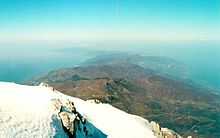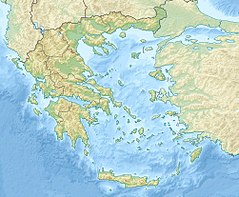Mount Athos
| Mount Athos | |
|---|---|
Ultra | |
| Coordinates | 40°09′30″N 24°19′38″E / 40.15833°N 24.32722°E |
| Geography | |
| Location | Europe |
| Country | Greece |
| Region | Agio Oros |
Europe | |
Mount Athos (/ˈæθɒs/; Greek: Ἄθως [ˈa.θos]) is a mountain on the Athos peninsula in northeastern Greece. It is an important center of Eastern Orthodox monasticism. The mountain and most of the Athos peninsula are governed as an autonomous region in Greece by the monastic community of Mount Athos, which is ecclesiastically under the direct jurisdiction of the Ecumenical Patriarch of Constantinople. The remainder of the peninsula forms part of the Aristotelis municipality. Women are prohibited from entering the area governed by the monastic community by Greek law and by religious tradition.[2]
Mount Athos has been inhabited since ancient times and is known for its long Christian presence and historical monastic traditions, which date back to at least 800 AD during the
Names
In the
Some languages of Orthodox tradition use names that translate to 'Holy Mountain', including Bulgarian, Macedonian and Serbian (Света Гора, Sveta Gora), and Georgian (მთაწმინდა, mtats’minda). However, not all languages spoken in the Eastern Orthodox world use this name: in the East Slavic languages (Russian, Ukrainian, and Belarusian) it is simply called Афон (Afon, meaning "Athos"), while in Romanian it is called "Mount Athos" (Muntele Athos or Muntele Atos).[citation needed]
Geography

The peninsula, the easternmost "leg" of the larger
The surrounding seas, especially at the end of the peninsula, can be dangerous. In ancient Greek history, two fleet disasters in the area are recorded: Herodotus claimed that in 492 BC,
Mount Athos has an extensive
Flora
Much of Mount Athos is covered with
Aleppo pine (
At least 35 plant species are endemic to Mount Athos, most of which are found in the area of the main summit in the south.
Mount Athos is also home to 350 species of mushrooms.[14][15][16][17][18]
Fauna
Mammals include the
Birds include the black stork (
History

Antiquity

In
The peninsula was on the invasion route of Xerxes I, who spent three years[27] excavating the Xerxes Canal across the isthmus to allow the passage of his invasion fleet in 483 BC. After the death of Alexander the Great, the architect Dinocrates (Deinokrates) proposed carving the entire mountain into a statue of Alexander.
Pliny the Elder stated in 77 AD that the inhabitants of Mount Athos could "live to their four hundredth year" due to the fact that they eat the skin of vipers.[28]
The lack of historical accounts shrouds the history of the peninsula during the later ages. Archaeologists have not been able to determine the exact location of the cities reported by Strabo. It is believed that they must have been deserted when Athos' new inhabitants, the monks, started arriving sometime before the ninth century AD.[29]
Early Christianity

According to the Athonite tradition, the
Historical documents on ancient Mount Athos history are very few. Monks have certainly been there since the fourth century, and possibly since the third. During
Later, during
Byzantine era and onwards
See also
Notes
- ^ St Gregory Palamas included this tradition in his book Life of Petros the Athonite, p. 150, 1005 AD.
References
- ^ "Mount Athos Home". Archived from the original on 1 October 2015. Retrieved 11 June 2016.
- ^ Why, Who, What (27 May 2016). "Why are women banned from Mount Athos?". BBC. Archived from the original on 14 February 2023. Retrieved 11 June 2023.
{{cite web}}: CS1 maint: multiple names: authors list (link) - ^ "Mount Athos". UNESCO World Heritage Convention. United Nations Educational Scientific and Cultural Organization. Archived from the original on 15 January 2021. Retrieved 30 October 2022.
- ISBN 978-0-19-257106-9. Archivedfrom the original on 21 June 2023. Retrieved 21 June 2023.
- ^ Robert Draper, "Mount Athos" Archived 11 August 2011 at the Wayback Machine, National Geographic magazine, December 2009
- )
- ^ Herodotus, Histories, book VI ("Erato"); Aeschylus, The Persians.
- ^ Diodorus Siculus, Bibliotheca historica XIII 41, 1–3.
- ^ "Footpaths of the Holy Mountain – FOMA". FOMA. 6 January 2019. Archived from the original on 16 June 2022. Retrieved 16 June 2022.
- ^ a b UN Environment World Conservation Monitoring Centre (22 May 2017). "Mount Athos". World Heritage Datasheet. Archived from the original on 7 August 2022. Retrieved 10 June 2022.
- )
- ^ )
- ^ Ganiatsas, K. (2003). I vlastesis kai i chloris tis chersonesou tou Agiou Orous.
- OCLC 503441715.
- ^ S. Dafis, ‘Anthrōpines drastēriotētes kai fysiko perivallon’, in S. Dafis et al. (eds.), Fysekai Perivallon sto Agion Oros, Thessalonica, 1998.
- ^ G. Sideropoulos, Agion Oros: anafores stēn anthropogeōgrafia, Athens, 2000, p. 28.
- ^ O. Rackham, ‘Our Lady’s Garden: the historical ecology of the Holy Mountain’, Friends of Mount Athos, Annual Report (2000), p. 50.
- ^ D. Babalonas, ‘Chlōrida kai endemismos tou Agiou Orous’, in M. Parcharidou and M. Fountoulēs (eds.), Agion Oros: fysē, latreia, technē, Vol. I, Thessalonica, 1999, p. 119.
- ^ )
- ^ Grimmett, R. & Jones, T. (eds) (1989). Important Bird Areas in Europe. Technical Publication #9, ICBP, Cambridge, U.K.
- ^ Heath, M. & Evans, M. (eds) (2000). Important Bird Areas in Europe: Priority Sites for Conservation Vol.2. BirdLife International, Cambridge, U.K.
- ^ "Mythology and History of Chalkidiki (Halkidiki)". chalkidiki.com. Archived from the original on 8 November 2023. Retrieved 8 November 2023.
- ^ Homer, Iliad 14,229.
- ^ Herodotus, Histories 6,44.
- ^ Herodotus, Histories 7,22.
- ^ Strabo, Geography 7,33,1.
- ^ Warry, J. (1998), Warfare in the Classical World, Salamander Book Ltd., London, p. 35
- ^ Pliny the Elder. [1] Archived 29 October 2021 at the Wayback Machine, Retrieved on 30 October 2021.
- ISBN 978-960-213-199-2.
- ISBN 0-300-093535.
- ^ Biography of Saint Athanasius the Athonite
External links
- . Encyclopædia Britannica. Vol. III (9th ed.). 1878. p. 14.







